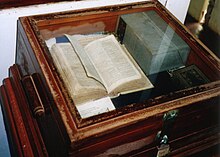
The Bounty Bible is a Bible that is thought to have been used on HMS Bounty, [1] [2] the ship famed for the Mutiny on the Bounty.

The Bounty Bible is a Bible that is thought to have been used on HMS Bounty, [1] [2] the ship famed for the Mutiny on the Bounty.

In January 1790, nine of the mutineers from the ship and their Tahitian companions (six men, eleven women and a baby) settled on Pitcairn Island, having anchored HMS Bounty in a small bay on the northern side of the island and set her on fire after everything of utility was landed. Pitcairn had ample food, water and land for everyone and a mild climate. However after four years the community was in turmoil due to discontent and disorder fuelled by home-distilled alcohol and disputes over women that eventually led to the deaths of all but two of the mutineers; the survivors being Ned Young and John Adams (also known as Alexander Smith). [3]
Young was an educated man and had been accepted as the leader of the island with Adams as his friend and deputy. He taught Adams to read using a Bible from HMS Bounty, which had been presented to the ship by the Naval and Military Bible Society (now the Naval Military & Air Force Bible Society) prior to sailing from England. [4] When Young died of asthma six years later Adams ruled the community of 11 women and 23 children and had them follow a Christian way of life, as described in the Bible, observing the rules of the Church of England. He built a school and educated the children, using the Bible to teach them to read and write a little. [5] [6] In September 1808 the crew of a sealing ship from New England named the Topaz captained by Mayhew Folger landed on Pitcairn to take on water and they found that the inhabitants spoke English. [7]
Adams died aged 63 on 23 March 1829 and the Bounty Bible was reportedly taken from the island on 17 July 1839, [1] having been bequeathed by a grandson to a carpenter named Levi Hayton from the whaling ship Cyrus , who took it home to Windsor, Connecticut. [8] In 1876 all the inhabitants of the Pitcairn Islands became Seventh Day Adventists after a successful Adventist mission. [9] The Bible was presented to the Connecticut Historical Society in 1896. [1]
Following a request for the return of the Bible by Pitcairn school teacher A.W. Moverley, [2] after 110 years in the United States the Connecticut Historical Society passed it to Sir Oliver Franks, the British Ambassador in Washington, D.C., in March 1949. It was then restored and rebound in London and the Colonial Office had it transported back to Pitcairn [9] [10] [11] via Fiji, where a wooden case was made for it, and it was presented to the people of the islands in February 1950, [2] 160 years after the mutineers settled on Pitcairn. [2] [3] The Bible was held at the Church in Adamstown, Pitcairn, which was built in 1954, until a museum was opened in 2006. The Bible is now in the museum, preserved under glass with a facsimile of William and Elizabeth Bligh's marriage certificate, a prayer book, and other artifacts. [2]
On 15 October 1940 the Pitcairn Islands Post Office opened with the release of the first Pitcairn Islands postage stamps; the 4d (fourpence) value issued on 1 September 1951 features an illustration of the Bible. [12]
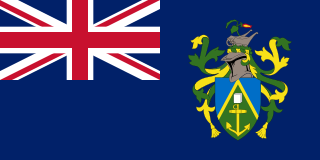
The Pitcairn Islands, officially the Pitcairn, Henderson, Ducie and Oeno Islands, are a group of four volcanic islands in the southern Pacific Ocean that form the sole British Overseas Territory in the Pacific Ocean. The four islands—Pitcairn, Henderson, Ducie and Oeno—are scattered across several hundred miles of ocean and have a combined land area of about 18 square miles (47 km2). Henderson Island accounts for 86% of the land area, but only Pitcairn Island is inhabited. The islands nearest to the Pitcairn Islands are Mangareva, 688 km to the west, and Easter Island, 1,929 km to the east.

Vice-Admiral William Bligh was a British officer in the Royal Navy and a colonial administrator. He is best known for the mutiny on HMS Bounty, which occurred in 1789 when the ship was under his command. After being set adrift in Bounty's launch by the mutineers, Bligh and those loyal to him all reached Timor alive, after a journey of 3,618 nautical miles. Bligh's logbooks documenting the mutiny were inscribed on the UNESCO Australian Memory of the World register on 26 February 2021.

The mutiny on the Royal Navy vessel HMS Bounty occurred in the South Pacific Ocean on 28 April 1789. Disaffected crewmen, led by acting-Lieutenant Fletcher Christian, seized control of the ship from their captain, Lieutenant William Bligh, and set him and eighteen loyalists adrift in the ship's open launch. The mutineers variously settled on Tahiti or on Pitcairn Island. Bligh navigated more than 3,500 nautical miles in the launch to reach safety and began the process of bringing the mutineers to justice.
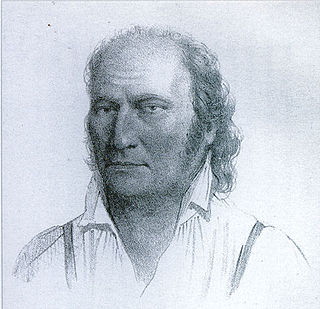
John Adams, known as Jack Adams, was the last survivor of the Bounty mutineers who settled on Pitcairn Island in January 1790, the year after the mutiny. His real name was John Adams, but he used the name Alexander Smith until he was discovered in 1808 by Captain Mayhew Folger of the American whaling ship Topaz. His children used the surname "Adams".

Adamstown is the capital of the Pitcairn Islands, and the only settlement on the Pitcairn Islands, the only British Overseas Territory that is located in the southern Pacific Ocean.

The history of the Pitcairn Islands begins with the colonization of the islands by Polynesians in the 11th century. Polynesian people established a culture that flourished for four centuries and then vanished. They lived on Pitcairn and Henderson Islands, and on Mangareva Island 540 kilometres (340 mi) to the northwest, for about 400 years.

Fletcher Christian was an English sailor who led the mutiny on the Bounty in 1789, during which he seized command of the Royal Navy vessel HMS Bounty from Lieutenant William Bligh.

HMS Pandora was a 24-gun Porcupine-class sixth-rate post ship of the Royal Navy launched in May 1779. The vessel is best known for its role in hunting down the Bounty mutineers in 1790, which remains one of the best-known stories in the history of seafaring. Pandora was partially successful by capturing 14 of the mutineers, but wrecked on the Great Barrier Reef on the return voyage in 1791. HMS Pandora is considered to be one of the most significant shipwrecks in the Southern Hemisphere.

Bounty Bay is an embayment of the Pacific Ocean into Pitcairn Island. It is named after the Bounty, a British naval vessel whose eighteenth-century mutiny was immortalized in the novel Mutiny on the Bounty, and the numerous subsequent motion pictures made of it. The mutineers sailed the Bounty to Pitcairn Island and destroyed it by fire in the bay. Current Pitcairn Islanders are largely patrilineal descendants of the mutineers and their Tahitian wives, as exhibited by some of their surnames.
Bounty Day is a holiday on both Pitcairn Island, destination of the Bounty mutineers, and on Norfolk Island. It is celebrated on 23 January on Pitcairn, and on 8 June on Norfolk Island, the day that the descendants of the mutineers arrived on the respective islands. It is named for HMS Bounty, although the ship never saw Norfolk Island.
Admiral Edward Edwards was a British naval officer best known as the captain of HMS Pandora, the frigate which the Admiralty sent to the South Pacific in pursuit of the Bounty mutineers.
Pitcairn Islanders, also referred to as Pitkerners and Pitcairnese, are the native inhabitants of the Pitcairn Islands, a British Overseas Territory including people whose families were previously inhabitants and maintaining cultural connections. Most Pitcairn Islanders are descendants of the Bounty mutineers.
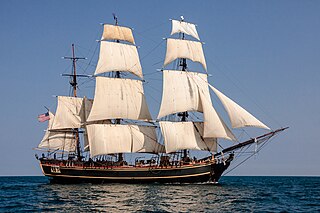
HMS Bounty, also known as HM Armed Vessel Bounty, was a British merchant ship that the Royal Navy purchased in 1787 for a botanical mission. The ship was sent to the South Pacific Ocean under the command of William Bligh to acquire breadfruit plants and transport them to the British West Indies to provide a cheap food source for the West Indies' large enslaved population. That mission was never completed owing to a 1789 mutiny led by acting lieutenant Fletcher Christian, an incident now popularly known as the Mutiny on the Bounty. The mutineers later burned Bounty while she was moored at Pitcairn Island in the Southern Pacific Ocean in 1790. An American adventurer helped land several remains of Bounty in 1957.
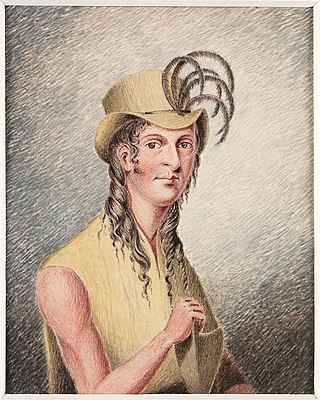
Thursday October Christian was the first son of Fletcher Christian and his Tahitian wife Mauatua. He was the first child born on the Pitcairn Islands after the mutineers took refuge on the island. Born on a Thursday in October, he was given his unusual name because Fletcher Christian wanted his son to have "no name that will remind me of England."

Pitcairn Island Museum is a museum in Pitcairn Island, a British Overseas Territory in the southern Pacific Ocean. Established in 2005, the museum's collection includes archaeological material from the earliest Polynesian settlers, as well as artefacts from HMS Bounty.
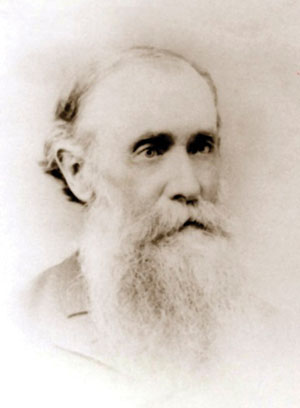
John I. Tay was a Seventh-day Adventist missionary who was known for his pioneering work in the South Pacific. It was through his efforts that most of the inhabitants of Pitcairn Island were converted to Adventism, and that the General Conference of Seventh-day Adventists purchased the Pitcairn schooner for missionary work in the South Pacific.

Pitcairn was a schooner built in 1890 for the Seventh-day Adventist Church for use in missionary work in the South Pacific. After six missionary voyages, the schooner was sold in 1900 for commercial use, and renamed Florence S. She was lost by stranding on the island of Mindoro, Philippine Islands, on 17 October 1912.

The complement of HMS Bounty, the Royal Navy ship on which a historic mutiny occurred in the south Pacific on 28 April 1789, comprised 46 men on its departure from England in December 1787 and 44 at the time of the mutiny, including her commander Lieutenant William Bligh. All but two of those aboard were Royal Navy personnel; the exceptions were two civilian botanists engaged to supervise the breadfruit plants Bounty was tasked to take from Tahiti to the West Indies. Of the 44 aboard at the time of the mutiny, 19 were set adrift in the ship's launch, while 25, a mixture of mutineers and detainees, remained on board under Fletcher Christian. Bligh led his loyalists 3,500 nautical miles to safety in the open boat, and ultimately back to England. The mutineers divided—most settled on Tahiti, where they were captured by HMS Pandora in 1791 and returned to England for trial, while Christian and eight others evaded discovery on Pitcairn Island.
Norfolk Islanders, also referred to as just Islanders, are the inhabitants or residents of Norfolk Island, an external territory of Australia. The Islanders have their own unique identity and are predominantly people of Pitcairn and English descent and to a lesser extent of Scottish and Irish.
William Peckover was a gunner in the Royal Navy and served on several vessels, most notably several commanded by James Cook or William Bligh.